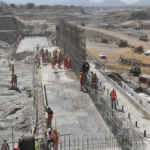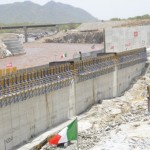 A dam for all (African Confidential)
A dam for all (African Confidential)
Ethiopia might attract Egyptian finance for its vast dam, although many financial and technical hurdles remain
Key regional meetings are about to take place on the Grand Ethiopian Renaissance Dam, probably Africa’s biggest-ever development project to be undertaken without grants or concessional finance. After Ethiopian Prime Minister Hailemariam Desalegn declared in early October that his government considered the GERD to be ‘jointly owned’ with Egypt and Sudan, a high-level Egyptian delegation led by Foreign Minister Nabil Fahmy is expected ‘soon’ in Addis Ababa.
Next week, the ministers responsible for water from the three countries (Ethiopia’s Alemayehu Tegenu, Egypt’s Mohamed Abdel Mottaleb and Sudan’s Usama Abdullah Mohamed el Hassan) meet in Khartoum to consider the dam’s implications for Egypt and Sudan. Ethiopia won’t only be attempting to reassure the downstream Nile users but also hoping to attract finance. It was always the late Prime MinisterMeles Zenawi’s hope that they would finance half of the estimated US$4.8 billion construction cost as part of ensuring future cheap electricity supplies.
The dam is ineligible for World Bank support or other concessional finance because multilateral lenders cannot support transnational projects that are initiated by only one country. Ethiopia has always called the GERD an issue of national sovereignty and denied the right of any other country to any say in its plans. Lenders would anyway be reluctant because no agreement with neighbouring countries yet exists to purchase the electricity generated at the dam. Such agreements are normally an essential part of dam planning.
The only recent technical assessment of the project has been the still-secret report by the International Panel of Experts (IPE) from all three countries, helped by four independent professionals, which was delivered in May (AC Vol 54 No 13, Dam and blast it). The report, though regarded as generally favourable to the dam, covers a wide variety of potential problems, which is probably why it has not been released. One water engineer who has seen the report and who has knowledge of the Nile Basin told Africa Confidential that Ethiopia’s own assessment had so far been ‘simplistic’.
Other issues have emerged from still unpublished academic studies by independent British and American scientists which we have obtained. We have also learned of an independent memorandum sent to the Egyptian government at the beginning of October which advised it to become a 50% shareholder in the dam.
One technical issue concerns modelling. One expert said that the modelling used for the flow of water into the Aswan High Dam, a crucial resource for Egypt’s irrigation management and hydroelectric power, needs improvement. It is also not clear in the IPE report, the expert told us, whether the Ethiopian government had taken a regional perspective in its rainfall projections or just considered flows of the Abay (Blue Nile), which is the tributary of the main Nile dammed by the GERD. ‘For example, if it’s a year with below normal precipitation in Ethiopia, did they also address the likelihood of a larger regional signal, perhaps causing lower precipitation from other important rivers such as the White Nile and Atbara?’ The White Nile, flowing from South Sudan, meets the Blue Nile at Khartoum to form the main Nile.
Flow gently
Flow is the crucial issue. A draft study which three Oxford Brookes University academics, Emanuele Ferrari, Professor Scott McDonald and Rehab Osman, presented in June at the 16th Annual Conference on Global Economic Analysis in Shanghai, China, said that the GERD’s reservoir capacity is roughly equivalent to the whole annual flow of the Nile at the Sudanese-Egyptian border, 65.5 bn. cubic metres (BCM). If all flow at that point were stopped, it would take a year to fill the reservoir. Possibly the most crucial and controversial factor is how long the reservoir would take to fill: if the time is short, shortages are suffered downstream. If it is too long, Ethiopia may not make a return on its power generation.
‘This loss to the downstream countries’ water share would take place only over the reservoir filling period,’ the Oxford Brookes paper states. However, the loss ‘might continue to induce noticeable long-term effects on the downstream countries. Evaporative losses from the dam’s reservoir would permanently reduce the flow of the Blue Nile. The magnitude of these losses is not accurately estimated yet.’
An Assistant Professor at the University of Wisconsin, Paul Block, author of a paper on filling the reservoir, says no filling rate has been established. ‘It becomes very important from a hydropower generation, economics and livelihood perspective, clearly for Ethiopia but also for Sudan and Egypt,’ he said. If Egypt, Sudan and Ethiopia decide to fill the reservoir slowly, abstracting ‘say 5% of the monthly flow, to minimize downstream effects,’ he says, ‘our analysis shows that the reservoir would actually never fill due to evaporation. Hydropower could be generated but never at design capacity.’ If Ethiopia were to impound water at a much higher rate, say 25% of the monthly flow, ‘certainly the reservoir would fill and they’d be generating hydropower at a much sooner time,’ says Block. That, however, would mean lower flows reaching Sudan and Egypt.
Ethiopia wants to earn valuable foreign exchange by exporting electricity all over the region but it could also be used for domestic consumption and would boost the economy. Filling the reservoir fast could be bad for the country, even if it meant generating power sooner. In an earlier research paper, Block had noted the importance of securing energy contracts before extensive generation. ‘Ethiopia may not be ready to immediately absorb all of this new electricity and if they begin generating but don’t have a buyer for a few years, this could be financially devastating,’ he says. Energy trade contracts secured prior to the dam’s generation stage, if any, are not publicly available.
Other academics don’t see evaporation as a problem. ‘It is completely out of the question that the GERD reservoir will not fill due to evaporation. The dam will fill during a few years,’ Professor Ånund Killingtveit of the Norwegian University of Science and Technology told us. ‘The design of GERD seems to be based on good hydrological data and there can be no doubt about the long-term viability of this project.’ Killingtveit acknowledges, however, that the devil is in the detail of how long it takes to fill the reservoir. ‘There will have to be some reduced flow in the Nile downstream from GERD during the first years after GERD is completed,’ he said, estimating that if filling took six years, about 12% less water would reach the Aswan Dam over that period, meaning less power-generation and less water for irrigation.
Yet he thinks it a price well worth paying because there would be, ‘significant long-term benefits for Sudan and Egypt, since the flow in the Blue Nile now will be much more evenly distributed during the year, with reduced floods during the wet season and much higher flow during the dry season from November to June.’ This demonstrates how intensely political the reservoir is, since Egypt will want the minimum disruption to the Aswan Dam.
The Spokesman for Egypt’s Ministry of Irrigation and Water Resources, Khaled M. Wassif, appears to agree with Killingtveit. ‘We want the end result of the dam to be achieved but without the side effects,’ he says, noting Egypt’s ultimate concern, reductions in flow. ‘Farmers sometimes come to us in our headquarters in the Ministry with a dead plant, as a symbol, a proof that a lack of water caused damage to them,’ Wassif said. Water is an extremely emotive issue and any impression of upstream countries ‘stealing Egypt’s water’ could cause popular unrest and create problems with Ethiopia. Wassif is conciliatory, ‘We’re not greedy,’ he says. ‘We don’t want development for just Egypt. We can achieve development in both countries.’
Dutch disease
Broader economic issues are also at stake. The Oxford Brookes paper fears that the dam could cause the ‘Dutch Disease’. When a country begins to export a natural resource on a large scale, often oil, the national currency rises in value and makes other exports uncompetitive. Any large increase in foreign currency earnings that might be expected from electricity export at the below-market price promised by Ethiopia would have consequences, the paper says, which are ‘not trivial’ and ‘likely to hold back Ethiopian development with adverse effects on rural households’.
However, they add that electricity exports ‘need to expand rapidly straight after the completion of GERD if the project is to be successful’. If exports expanded quickly, the Dutch Disease could be magnified and that would also incline Ethiopia to fill the reservoir rapidly.
Sudan’s position is different from Egypt’s. It has strong concerns about the safety of the dam because, ‘They know if the dam fails, it will destroy all the cities and villages on the Blue Nile past Khartoum,’ according to Salman Mohamed Ahmed Salman, a Sudanese water lawyer who until December 2009 was lead counsel with the Legal Vice-Presidency of the World Bank and the Bank’s advisor on water law. ‘They are less concerned about the decrease in the flow of the Nile waters as Sudan uses only 12 BCM of its share of 18.5 BCM under the 1959 [Nile Waters] treaty with Egypt.’
Financial strain
The Ethiopian government estimated the cost of the dam at $4.8 bn., equivalent to about 11.2% of Ethiopia’s 2012 economic output ($43.13 bn. in 2012, according to World Bank data). Some engineers believe the 6,000 megawatt generating plant is too big and others doubt the provisional cost estimate. Mamdouh Hamza, a leading Egyptian dam engineer, says his rough calculations put the cost ‘in excess of’ $7 bn.’ or 16.2% of Ethiopia’s gross domestic product.
Without advance electricity agreements, Hamza says the economic viability of the dam is in question. According to Block, running out of funds well into the building process could be problematic. ‘It’s not like the Jonglei Canal, where construction ceased and there’s a half-built canal with a rusted bulldozer at the end. There could be significant infrastructure in the River, actually altering the flow regime. What then? Do outside experts pitch in to continue, to remove it or to leave it as is?’
Wassif’s answer to the financial problem is to reach agreement with the countries in the Nile Basin Cooperative Framework Agreement. After rows with Egypt in June, Ethiopia unilaterally ratified the NBCFA without Egypt’s consent. Egypt officially hews to the 1891 and 1959 Nile treaties. If all the countries would sign up to the Framework Agreement, that would remove a significant obstacle to multilateral finance. Ethiopia’s latest moves appear conciliatory, no doubt encouraged by the removal of President Mohamed Mursi in Egypt.
Other finance comes from a programme urging Ethiopians to buy corporate bonds issued by the Ethiopian Electric Power Corporation. The government has built up high hopes of completing its more or less self-financed dam by 2018 and on 30 December 2010, EEPCo contracted the Italian company Salini CostruttoriSpA to build the GERD, according to Salini’s December 2012 annual report. Some economists have expressed concern that a levy on salaries and businesses could seriously affect the availability of capital elsewhere in the economy, especially since foreign direct investment and domestic capital are so scarce.
The Egyptian role could be decisive. Hamza believes that as long as Egypt’s quota of Nile water is not affected, it should buy into the dam. It needs to invest $3bn. in the next five years to meet domestic electricity demand, he says, and it could meet that with power from the GERD. He suggests a pre-purchase agreement for power, up to 20% of the dam’s capital cost, or even a 50% equity share, with work guaranteed for Egyptian companies.
Hamza’s view is more favourable than those of previous Egyptian governments. Mohamed Nasreddin Allam, ex-President Mohamed Hosni Mubarak’s Minister of Water Resources and Irrigation in 2009-11, toldAC that when he was Minister, Mubarak’s opinion was that he ‘rejected the whole dam scheme’ (AC Vol 51 No 17, The battle of the Nile). Now Professor of Water Resources at Cairo University and a water consultant, Allam says that in 2010 President Mubarak’s government received detailed technical studies for four Blue Nile dams from the Ethiopian government and rejected them all. Egypt said Ethiopia had not provided enough details.
The information which Ethiopia is now giving to Egypt is ‘neither satisfactory, nor adequate even for the design of the dam,’ says Hamza. ‘To ascertain the dam’s integrity, there is a certain minimum level of information the Egyptian government needs.’ Because dams now work automatically through connection to turbines, the software Ethiopia will use to operate the dam is ‘as important as the construction of the dam itself,’ he says. From outside Africa there is also interest. In late April, Ethiopia’s deputy Prime Minister of Economy and Finance Debretsion Gebremichael told the press that China Electric Power Equipment and Technology has plans to finance a $1 bn. 619-km transmission line that will bring electricity from the GERD to the Ethiopian capital; and that funding would come primarily from the Export-Import Bank of China. Plans for a national distribution grid have lagged behind the plans for generation and could prove to require a
national effort almost as monumental as building the dam itself.
When the three water ministers meet in Khartoum next week, the IPE recommendations will be summarised and refined and the committee will ‘essentially reproduce most of the [existing] studies of the dam,’ Allam says. He doesn’t want to prolong the process and instead recommends that Egypt request ‘openly and frankly what they want’ from Ethiopia to establish a trade-off between the three country’s interests, without any losers.







![Ethiopia will push forward with construction of the Dam but could be forced to slow the pace [The Economist Intelligence Unit]](https://www.ethiopianopinion.com/wp-content/uploads/2013/10/egypt21-150x150.gif)









![23-year-old Ethiopian surprises his mother with a cheque that pays off her mortgage [May 2013] 23-year-old Ethiopian surprises his mother with a cheque that pays off her mortgage [May 2013]](https://www.ethiopianopinion.com/wp-content/plugins/top-10/timthumb/timthumb.php?src=http%3A%2F%2Fwww.ethiopianopinion.com%2Fwp-content%2Fuploads%2F2014%2F03%2Fdearmother-150x150.jpg&w=&h=&zc=1&q=75)










Join Conversations